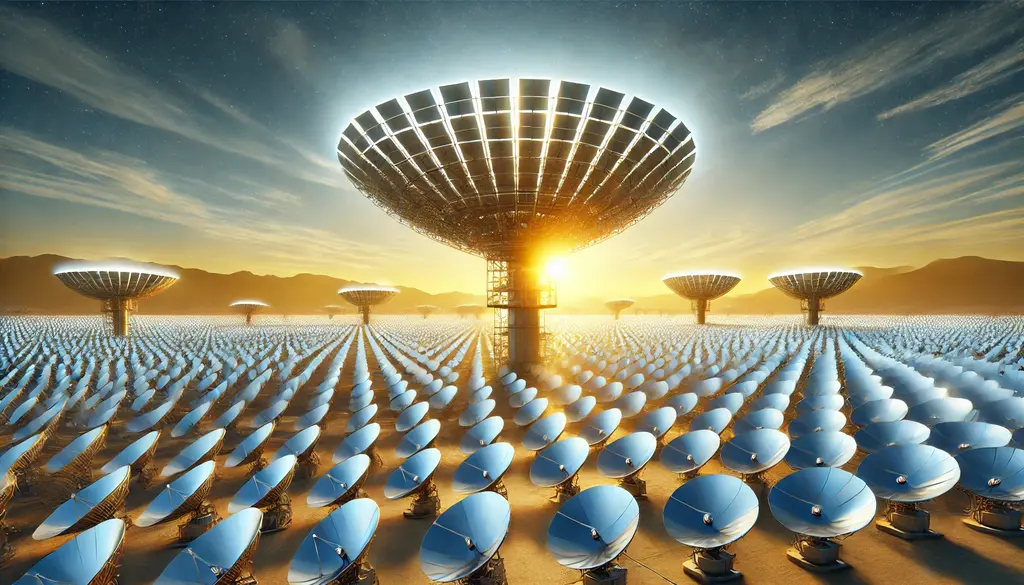The race for clean energy in the U.S. is heating up—literally. Heliostat technologies focus sunlight so intensely it can melt salt and generate massive amounts of power. Backed by new research and DOE programs, they could soon cut costs in half and help lead America into a zero-carbon future.
What Are Heliostat Technologies?
Heliostat technologies are a key part of Concentrated Solar Power (CSP) systems. A heliostat is a large, flat mirror. It sits on a special stand that can move in two ways. Its only job is to move all day and bounce sunlight onto one spot. This spot is a fixed target. This is different from a regular solar panel. A regular panel just sits there and absorbs light.
A heliostat follows the sun all day long. It uses a computer to aim the light at a central receiver. When thousands of these mirrors work together, they can focus a lot of solar energy. All that energy goes to a small area. This focused energy makes a lot of heat. The heat can get hot enough to melt salt.
This intense heat is why heliostats are so important for CSP plants. The heat turns a fluid into steam. The steam then spins a turbine. This generates electricity. By focusing sunlight so well, heliostats make solar power plants more efficient. This also helps lower the cost of making electricity. This makes them a vital part of clean energy.
The Role of Heliostat Technologies in Concentrating Solar-Thermal Power
Heliostat technologies are very important in large solar power plants. They are used in Concentrating Solar-Thermal Power (CSP) plants. Normal solar panels turn sunlight into electricity right away. CSP plants are different. They use mirrors to make heat. This heat is then used to make power.
The process works like this: thousands of heliostats focus sunlight onto a central receiver. This receiver is a tower. It is usually in the middle of a large field of mirrors. The strong, focused sunlight heats a fluid inside the tower. It gets very hot, often over 1,000°F. This heat creates steam. The steam then spins a turbine. This turbine makes electricity. It works just like a traditional power plant.
Heliostats are key to making these big projects work well and cheaply. In the U.S., some plants use this technology. Examples are the Ivanpah plant in California and the Crescent Dunes in Nevada. The Ivanpah plant uses over 173,500 heliostats. They help power its three towers.
New heliostat designs are better now. They are more accurate and last longer. This makes the power plants more efficient. Engineers are making these mirrors lighter and more precise. They are also improving the software that controls them. This helps reduce the amount of land needed. It also makes sure more sunlight hits the target. This not only makes more energy. It also helps lower the cost of the mirrors. The cost of the mirrors can be a big part of a CSP plant’s total cost.
Recent Innovations in Heliostat Technologies
Heliostat technology is always changing. New ideas want to make Concentrating Solar Power (CSP) better and cheaper. These new ideas are needed so that this renewable energy can compete with fossil fuels.
Smaller, Modular Heliostats
One big new trend is smaller heliostats. In the past, heliostats were huge. They had to be built on site. Now, companies are making smaller ones in factories. They are easier to move and install. This “plug-and-play” method saves a lot on labor. It also makes building a solar field much faster.
Advanced Tracking Systems
Another major new idea is better tracking and control software. Old heliostats used one computer for the whole field. New systems use smarter, wireless controls. Some even use AI. This helps them make small, real-time changes. They can adjust for wind and temperature. This makes sure each mirror is aimed perfectly. This sends more sunlight to the receiver. It increases the plant’s total power output. AI is also used for maintenance. It can find problems before they happen.
Lightweight Materials
Researchers are also looking at lighter materials. They want to make the heliostat structures lighter. They can use materials like composites instead of steel. This makes the mirrors cheaper to make and move. It also means they need less strong support structures.
A lot of this research is backed by the U.S. Department of Energy (DOE). The DOE has programs like the HelioCon and the American-Made Heliostat Prize. They are pushing for new ideas to lower costs and improve performance. These efforts are building the future of CSP plants.
Challenges Facing Heliostat Technologies
Heliostat technology has great potential. But it also has big problems. Researchers are working on these issues.
High upfront cost of CSP vs. PV solar
One main problem is the high cost. Concentrating Solar-Thermal Power (CSP) plants cost a lot to build. They are more complex than regular solar farms. This makes them more expensive. They are at a disadvantage against regular solar. The price of regular solar is falling fast. This is especially true when it is used with cheaper batteries.
Land Use and Environmental Concern
Another problem is how much land they use. CSP plants need huge, open areas for the mirrors. This can harm animal habitats. It also uses a lot of water. This is a special concern in dry areas. The bright solar rays can also harm or kill birds.
Maintenance and Durability of Mirrors
Maintaining the mirrors is also a big factor. Heliostats must be cleaned often. This removes dust and dirt. They must also survive bad weather like wind and sandstorms. Keeping thousands of mirrors working for 30 years needs constant upkeep. This adds to the long-term cost.
The technology also has strong competition. Solar panels with batteries are becoming cheaper. CSP plants can store energy to make power 24/7. But the cost of batteries is dropping fast. This makes solar panels with batteries a strong competitor. Ongoing government help and research are needed. This will help heliostats meet these challenges. It will help them have a place in our future energy grid.
Future Outlook for Heliostat Technologies in the U.S.
The future of heliostat technology in the U.S. is focused on overcoming its current problems. The goal is to make it a key part of our clean energy grid. The U.S. Department of Energy (DOE) is leading this effort. They have set a big goal. They want to cut the cost of heliostats by more than 50% in the next ten years. This would make them much more competitive with other energy sources.
A big goal for the future is to create hybrid systems. These systems would combine different solar technologies. We can mix Concentrating Solar-Thermal Power (CSP) with thermal storage and regular solar panels. This can create a powerful and reliable energy source. The solar panels provide cheap power during the day. The CSP’s stored heat provides clean power at night. This helps keep the power grid stable.
Heliostats also have a big role beyond just electricity. They can help industries go green. Many industries, like steel and cement, need very high temperatures. Heliostats can provide this high heat directly. This removes the need for fossil fuels. It is a path to a future of zero-carbon manufacturing.
By investing in this research, the U.S. can become a world leader in CSP technology again. Other countries have been leading in building CSP plants. But the U.S. has the research and experts to build the next generation of heliostats. This will help create a stronger and more sustainable energy future.
FAQs
What are heliostat technologies?
Heliostat technologies use mirrors that move with the sun. They reflect sunlight onto a central receiver. The heat from this sunlight powers turbines. Heliostats are an important part of Concentrating Solar-Thermal Power (CSP) plants.
How do heliostats work in CSP plants?
Many heliostats point sunlight toward a tower receiver. The heat warms a fluid inside the tower. The fluid turns into steam. The steam spins turbines. This creates electricity. It works like a traditional power plant, but it uses solar energy.
What are the latest innovations in heliostat technologies?
New heliostat designs are smaller and made in factories. Advanced tracking systems use AI for better accuracy. Lightweight materials replace heavy steel. These changes reduce costs. They also make solar fields easier and faster to build.
What challenges do heliostat technologies face?
CSP plants are very expensive to build. They also need large open land. The mirrors must be cleaned and maintained often. Heliostats face competition from solar panels with batteries. Panels with storage are now much cheaper.
What is the future of heliostat technologies in the U.S.?
The DOE wants to cut heliostat costs by more than 50% in the next decade. Future CSP plants may combine with solar panels and storage. This will give clean power day and night. Heliostats may also provide high heat for industries like steel and cement.


